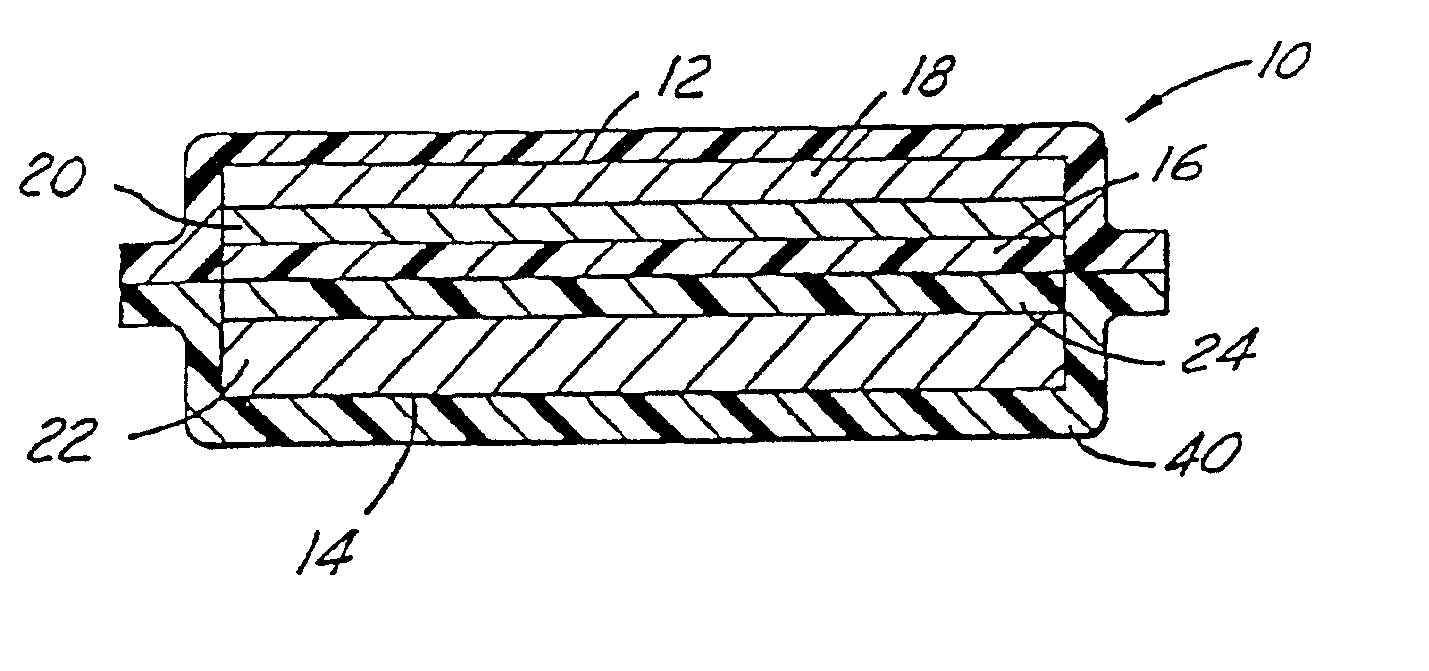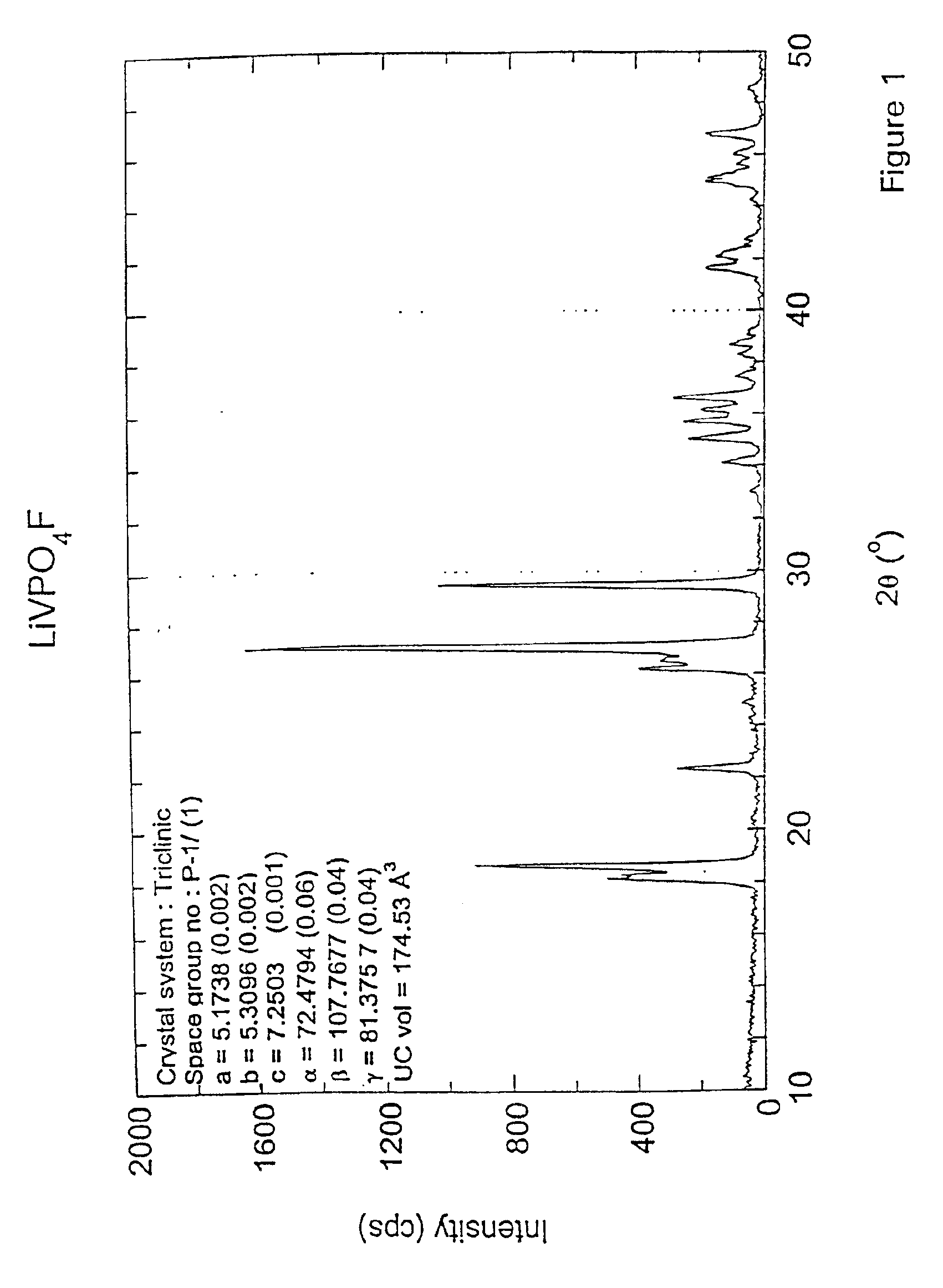Lithium metal fluorophosphate materials and preparation thereof
a technology of lithium metal fluorophosphate and phosphate, which is applied in the direction of cell components, final product manufacturing, sustainable manufacturing/processing, etc., can solve the problems of difficult to synthesize nickel compounds, low discharge capacity of cells containing such cathodes, and relatively high cost of cobalt compounds, etc., to achieve rapid and cheap production, good discharge capacity, and economic production
- Summary
- Abstract
- Description
- Claims
- Application Information
AI Technical Summary
Benefits of technology
Problems solved by technology
Method used
Image
Examples
example i
Reaction 1(a)—Using hydrogen to form precursors
0.5 V2O5+NH4H2PO4+H2→VPO4+NH3+2.5 H2O(a) Pre-mix reactants in following proportions using ball mill. Thus,
0.5 mol V2O5 = 90.94 g1.0 mol NH4H2PO4 =115.03 g(b) Pelletize the power mixture.(c) Heat to 300° C. at a rate of 2° C. / minute in a flowing H2 atmosphere. Dwell for 8 hours at 300° C.(d) Cool at 2° C. / minute to room temperature.(e) Powderize and re-pelletize.(f) Heat to 850° C. in a flowing H2 atmosphere at a rate of 2° C. / minute. Dwell for 8 hours at 850° C.(g) Cool at 2° C. / minute to room temperature.
Reaction 1(b)—formation of lithium vanadium fluorophosphate
LiF+VPO4→LiVPO4F(a) Pre-mix reactants in equi-molar portions using a ball mill. Thus,
1 mol LiF = 25.94 g1 mol VPO4 =145.91 g(b) Pelletize powder mixture.(c) Heat to 700° C. at a rate of 2° C. / minute in an air atmosphere in a covered nickel crucible. Dwell for 15 minutes at 700° C.(d) Cool to room temperature at about 50° C. / minute.(e) Powderize pellet.
example ii
Reaction 2(a)—Using a carbothermal method to form precursors.
0.5 V2O5+NH4H2PO4+C→VPO4+NH3+1.5H2O+CO(a) Pre-mix reactants in the following proportions using ball mill. Thus,
0.5 mol V2O5 = 90.94 g1.0 mol NH4H2PO4 =115.03 g1.0 mol carbon = 12.0 g(Use 10% excess carbon → 13.2 g) (b) Pelletize powder mixture(c) Heat pellet to 300° C. at a rate of 2° C. / minute in an inert atmosphere (e.g., argon). Dwell for 3 hours at 300° C.(d) Cool to room temperature at 2° C. / minute.(e) Powderize and re-pelletize.(f) Heat pellet to 850° C. at a rate of 2° C. / minute in an inert atmosphere (e.g. argon). Dwell for 8 hours at 850° C. under an argon atmosphere.(g) Cool to room temperature at 2° C. / minute.(h) Powderize pellet.
Reaction 2(b)—formation of lithium vanadium fluorophosphate
LiF+VPO4→LiVPO4F(a) Pre-mix reactants in equi-molar portions using a ball mill. Thus,
1 mol LiF = 25.94 g1 mol VPO4 =145.91 g(b) Pelletize powder mixture.(c) Heat to 700° C. at a rate of 2° C. / minute in an air atmosphere in a nic...
example iii
Reaction 3(a)—Formation of aluminum phosphate.
Al(OH)3+NH4H2PO4→AlPO4+NH3+3H2O
(a) Premix reactants in equi-molar portions using a ball mill. Thus,
1.0 mol Al (OH)3 = 78.0 g1.0 mol NH4H2PO4 =115.03 g(b) Pelletize powder mixture.(c) Heat to 950° C. at a rate of 2° C. / minute in an air atmosphere. Dwell for 8 hours at 950° C.(d) Cool to room temperature at about 50° C. / minute.(e) Powderize.
Reaction 3(b)—Formation of lithium vanadium aluminum fluorophosphate
0.9 VPO4+0.1AlPO4+1.0LiF→LiV0.9Al0.1PO4F(a) Pre-mix reactants in the following proportions using ball mill. Thus,
0.9 mol VPO4 =131.3 g0.1 mol AlPO4 = 12.2 g1.0 mol LiF = 25.9 g(b) Pelletize powder mixture.(c) Heat to 700° C. at a rate of 2° C. / minute in a nickel crucible in either an air or inert atmosphere. Dwell for 15 minutes at 700° C.(d) Cool to room temperature at about 50° C. / minute.(e) Powderize.
PUM
| Property | Measurement | Unit |
|---|---|---|
| voltage/capacity | aaaaa | aaaaa |
| temperature | aaaaa | aaaaa |
| temperature | aaaaa | aaaaa |
Abstract
Description
Claims
Application Information
 Login to View More
Login to View More - R&D
- Intellectual Property
- Life Sciences
- Materials
- Tech Scout
- Unparalleled Data Quality
- Higher Quality Content
- 60% Fewer Hallucinations
Browse by: Latest US Patents, China's latest patents, Technical Efficacy Thesaurus, Application Domain, Technology Topic, Popular Technical Reports.
© 2025 PatSnap. All rights reserved.Legal|Privacy policy|Modern Slavery Act Transparency Statement|Sitemap|About US| Contact US: help@patsnap.com



